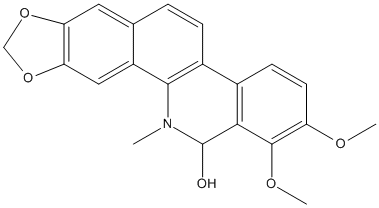8-Hydroxydihydrochelerythrine
General
Type : Alkaloid,Benzodioxo,Phenanthridinium
Chemical_Nomenclature : 1,2-dimethoxy-12-methyl-13H-[1,3]benzodioxolo[5,6-c]phenanthridin-13-ol
Canonical SMILES : CN1C(C2=C(C=CC(=C2OC)OC)C3=C1C4=CC5=C(C=C4C=C3)OCO5)O
InChI : InChI=1S\/C21H19NO5\/c1-22-19-13(5-4-11-8-16-17(9-14(11)19)27-10-26-16)12-6-7-15(24-2)20(25-3)18(12)21(22)23\/h4-9,21,23H,10H2,1-3H3
InChIKey : RATMHCJTVBHJSU-UHFFFAOYSA-N
Other name(s) : CHEMBL3220152
MW : 365.4
Formula : C21H19NO5
CAS_number : 4070-42-2
PubChem : 15940321
UniChem : RATMHCJTVBHJSU-UHFFFAOYSA-N
IUPHAR :
Wikipedia :

Target
Families : 8-Hydroxydihydrochelerythrine ligand of proteins in family: ACHE
Stucture :
Protein : human-ACHE
References (2)
| Title : Simple analogues of natural product chelerythrine: Discovery of a novel anticholinesterase 2-phenylisoquinolin-2-ium scaffold with excellent potency against acetylcholinesterase - Zhou_2020_Eur.J.Med.Chem_200_112415 |
| Author(s) : Zhou B , Li H , Cui Z , Li D , Geng H , Gao J , Zhou L |
| Ref : Eur Journal of Medicinal Chemistry , 200 :112415 , 2020 |
| Abstract : Zhou_2020_Eur.J.Med.Chem_200_112415 |
| ESTHER : Zhou_2020_Eur.J.Med.Chem_200_112415 |
| PubMedSearch : Zhou_2020_Eur.J.Med.Chem_200_112415 |
| PubMedID: 32454229 |
| Title : 8-hydroxydihydrochelerythrine and 8-hydroxydihydrosanguinarine with a potent acetylcholinesterase inhibitory activity from Chelidonium majus L - Cho_2006_Biol.Pharm.Bull_29_2317 |
| Author(s) : Cho KM , Yoo ID , Kim WG |
| Ref : Biol Pharm Bull , 29 :2317 , 2006 |
| Abstract : Cho_2006_Biol.Pharm.Bull_29_2317 |
| ESTHER : Cho_2006_Biol.Pharm.Bull_29_2317 |
| PubMedSearch : Cho_2006_Biol.Pharm.Bull_29_2317 |
| PubMedID: 17077538 |